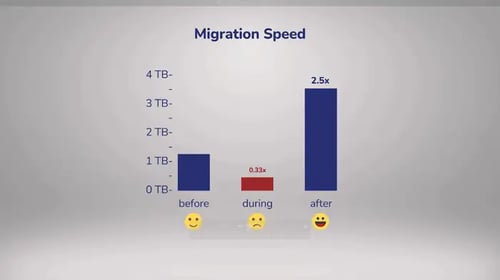Understanding the Limits of Microsoft’s Purview eDiscovery
Take a look at some of the limits of using Microsoft Purview for eDiscovery, and how our solution, Expireon, can help your organisation.
-3.png?width=250&height=33&name=Untitled%20design%20(18)-3.png)
In this video MJ explains how Cloudficient first noticed Office 365 Service Protection Throttling and the effect it had ...
In this video MJ explains how Cloudficient first noticed Office 365 Service Protection Throttling and the effect it had on migration speeds.
In the video you will have seen the effects that service protection throttling had on a regular Office 365 migration. Below is the graph summarising the migration speeds and what the speed was like after we made engineering changes in our ReMAD platform to eliminate the effects of service protection throttling:
It's a dramatic change and it's why you should migrate with EVComplete to Office 365 today!
Below is a transcript of the video:

Hi and welcome,
For organizations moving to the cloud, moving there quickly with all your legacy archive data is important. I’m MJ and today I’d like to provide a brief summary of how Cloudficient became aware of Service Protection Throttling and how this can impact the speed of your migration to Office 365.
We first encountered Service Protection Throttling back in December 2020. It appeared as a sudden slow-down of a previously working, and quite fast, customer migration.
Our blog has a detailed article about Service Protection Throttling which I encourage you to read.
It was confirmed by Microsoft that the customer involved was unthrottled, yet the performance issues persisted. Eventually after some days of working with Microsoft on the issue, it was said that what we were encountering was a whole new level of throttling, and it was called Service Protection Throttling.
Once we understood the limitations that this type of throttling was placing on customers who were migrating legacy data to Office 365, we quickly made some agile engineering changes to eliminate the effects of the restriction.
During just 24 hours we coded a change, tested it, and deployed it. We also discovered that it was not just affecting customers performing legacy archive migration, it was also affecting people migrating PST data into the Microsoft cloud, and people doing tenant-to-tenant migrations. Of course, it wasn’t just our customers, it was across the whole spectrum of customers and impacted all migration vendors.
Let’s take a look at migration speeds before the problem happened, whilst the problem was happening, and after we implemented changes to counteract the effects of the throttling.
Just before I share the data with you, you should understand that all migrations are different in terms of speed and lots of other factors. Your migration speeds with us or other vendors might be completely different to the numbers I am going to share here. Rest assured though that these are real numbers from a real customer where nothing else changed during the timeframe of this issue.
In other words: we didn’t cheat!
Before the problem was encountered, this particular customer was migrating legacy archive data into Office 365 at 1.2 Terabytes a day, on average.
When the problem appeared and was being investigated the migration slowed to just 300 to 400 Gigabytes per day.
This is roughly one third of the previous throughput.
Once the problem was understood, and the change implemented we saw a whole different picture.
The speed increased. A lot.
It increased to 3.5 Terabytes per day.
This is roughly 2 and a half times the previous average speeds.
There are some vendors who say that this type of throttling doesn’t exist, but we’ve had confirmation from Microsoft and talked it through with many technical contacts across our industry.
The net result is that the new throttling has been implemented, and in fact additional throttling of this type might be introduced in the near future.
So, if you’re planning to migrate legacy data to Office 365 or do tenant to tenant migrations it’s essential that you do a proof of concept, and with our solution you’ll see a huge speed difference.
With unmatched next generation migration technology, Cloudficient is revolutionizing the way businesses retire legacy systems and transform their organization into the cloud. Our business constantly remains focused on servicing client needs and creating solution offerings that match them.
If you would like to learn more about how to bring Cloudficiency to your migration project, please visit our website: cloudficient.com.
Take a look at some of the limits of using Microsoft Purview for eDiscovery, and how our solution, Expireon, can help your organisation.
In this video we explain some of the problems of migrating an Exchange Journal to Office 365, and how Expireon can help.
In this video you'll get detailed information about migration and consolidation challenges and solutions. Dive in, and get ready to start your...